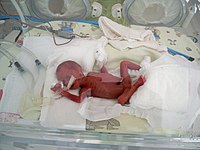
Photo from wikipedia
Background The kidney ontogenesis is the most structurally affected by gestational protein restriction, reducing 28% of their functional units. The reduced nephron number is predictive of hypertension and cardiovascular dysfunctions… Click to show full abstract
Background The kidney ontogenesis is the most structurally affected by gestational protein restriction, reducing 28% of their functional units. The reduced nephron number is predictive of hypertension and cardiovascular dysfunctions that are generally observed in the adult age of most fetal programming models. We demonstrate miRNAs and predict molecular pathway changes associated with reduced reciprocal interaction between metanephros cap (CM) and ureter bud (UB) and a 28% decreased nephron stem cells in the 17 gestational days (17GD) low protein (LP) intake male fetal kidney. Here, we evaluated the same miRNAs and predicted targets in the kidneys of 21GD and at 7 days of life (7DL) LP offspring to elucidate the molecular modulations during nephrogenesis. Methods Pregnant Wistar rats were allocated into two groups: NP (regular protein diet- 17%) or LP (diet-6%). miRNA transcriptome sequencing (miRNA-Seq) was performed on the MiSeq platform from 21GD and 7DL male offspring kidneys using previously described methods. Among the top 10 dysfunctional regulated miRNAs, we validated 7 related to proliferation, differentiation, and apoptosis processes and investigated predicted target genes and proteins by RT-qPCR and immunohistochemistry. Results In 21GD, LP fetuses were identified alongside 21 differently expressed miRNAs, of which 12 were upregulated and 9 downregulated compared to age-matched NP offspring. In 7-DL LP offspring, the differentially expressed miRNAs were counted to be 74, of which 46 were upregulated and 28 downregulated. The curve from 17-GD to 7-DL shows that mTOR was fundamental in reducing the number of nephrons in fetal kidneys where the mothers were subjected to a protein restriction. IGF1 and TGFβ curves also seemed to present the same mTOR pattern and were modulated by miRNAs 181a-5p, 181a-3p, and 199a-5p. The miRNA 181c-3p modulated SIX2 and Notch1 reduction in 7-DL but not in terms of the enhanced expression of both in the 21-GD, suggesting the participation of an additional regulator. We found enhanced Bax in 21-GD; it was regulated by miRNA 298-5p, and Bcl2 and Caspase-3 were controlled by miRNA (by 7a-5p and not by the predicted 181a-5p). The miRNA 144-3p regulated BCL6, which was enhanced, as well as Zeb 1 and 2 induced by BCL6. These results revealed that in 21GD, the compensatory mechanisms in LP kidneys led to the activation of UB ramification. Besides, an increase of 32% in the CM stem cells and a possible cell cycle halt of renal progenitor cells, which remaining undifferentiated, were observed. In the 7DL, much more altered miRNA expression was found in LP kidneys, and this was probably due to an increased maternal diet content. Additionally, we verified the activation of pathways related to differentiation and consumption of progenitor cells.
Journal Title: Frontiers in Physiology
Year Published: 2021
Link to full text (if available)
Share on Social Media: Sign Up to like & get
recommendations!